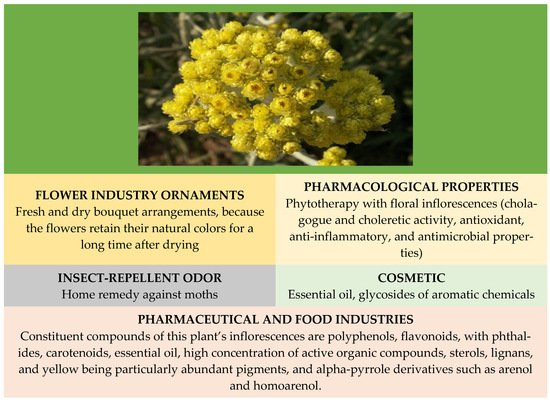Helichrysum arenarium (L.) Moench, belonging to the Asteraceae family, is known in traditional medicine for its diuretic, choleretic, and anti-inflammatory properties. Helichrysum arenarium (sandy everlasting) is a source of active pharmacological compounds used in complementary medicine to prevent digestive and hepatobiliary illnesses.
- Helichrysum arenarium
- antimicrobial
- antioxidant
- anti-inflammatory
1. Introduction
2. Area of Spread, Cultivation Techniques, and Applications
4. Bioactive Compounds
5. Extraction Products
| Extraction Technique | Solvent | Active Constituents | References |
|---|---|---|---|
| Distillation | Water | Monoterpenoids, sesquiterpenoids, phenolic compounds |
[18,52,56] |
| Maceration | Alcohol | Alkaloids, carotenes, flavonoids, tannins |
[1,56] |
| Solvent extraction or enfleurage |
Solvent organic | Monoterpenes, sesquiterpenes, monoterpenoids, phenolic compounds, carotenes |
[52,56,57,59,61] |
| Ultrasonic-assisted extraction (UAE) or sonication |
Ethanol aqueous solution |
Phenolic acids and flavonoids | [51,54,56,60,62] |
| Supercritical fluid extraction (SFE) | Supercritical carbon dioxide |
Nonpolar natural products such as lipid and volatile oil. | [53,54,55,56] |
| Microwave-assisted extraction (MAE): two types of methods: 1. solvent-free extraction; 2. solvent extraction |
1. usually for volatile compounds; 2. usually for nonvolatile compounds |
Essential oils: - Monoterpene hydrocarbons - Sesquiterpene hydrocarbons - Oxygenated monoterpenes - Oxygenated sesquiterpenes |
[52,56,58] |
6. Pharmacological Properties
6.1. Choleretic and Cholagogue Activities
6.2. Antioxidant Activities
6.3. Anti-Inflammatory Activities
6.4. Antimicrobial Activities
Antibacterial, antiviral, and antifungal properties of the Helichrysum species have been investigated in several Euroasia countries. Moreover, the European Medicine Agency published a report in 2015 on the pharmacological effects, clinical efficacy and safety, and antimicrobial properties of H. arenarium (L.) Moench [19]. The first investigation of the antibacterial activity of the everlasting flower flavonoid compounds was performed in the former Soviet Union by Khristenko LA and concluded that the preparations in the concentration of 20–40 μg/mL were active against two important Gram-positive species (Staphylococcus sp. and Streptococcus sp.) [84]. Later, aerial parts of the plant or the whole overground plant were used to prepare infusions, decoctions, essential oils, and extracts with different qualitative content.
The antimicrobial activity of essential oils of H. arenarium has been investigated on different test microorganisms, clinical isolates, and food contamination microbes. Rančić et al., 2005 tested the antibacterial activity of 1–5 μL of everlasting flower essential oil on Escherichia coli ATCC 35,218, Micrococcus luteus ATCC 9341, Pseudomonas tolaasii isolated from Agaricus bisporus, Salmonella enteritidis ATCC 13,076, S. Typhimurium ATCC 13,311, Staphylococcus aureus ATCC 6538, and S. epidermidis ATCC 12,228 and concluded that at the minimum volume (1 μL) the oil had activity against all bacterial species tested [45].
Helichrysum arenarium extracts and herbal teas have been used traditionally in European countries. The antioxidant and antimicrobial activities of two subspecies of H. arenarium (L.) Moench, erzincanicum Davis and Kupicha, Erzican and rubicundum (C.Koch.) Davis and Kupicha, Erzurum, collected from different regions of Turkey, were analyzed. Methanolic extracts from the whole dried plants were screened against 15 strains of bacteria and fungi using the agar-well diffusion method, and the results were compared with standard antibiotics [87,88]. Statistical differences were found among the chemical compositions and the antimicrobial and antioxidant activities of these subspecies. Additionally, extracts were active against Aeromonas hydrophila, B. brevis, B. cereus, Klebsiella pneumoniae, Pseudomonas aeruginosa, and S. aureus ATCC 29,213, but no activity was detected against tested strains of E. coli, Morganella morganii, Proteus mirabilis, Mycobacterium smegmatis, Yersinia enterocolitica, or yeast S. cerevisiae [87,88]. However, at the highest concentration (100,000 µg/mL), methanolic extracts were similar to or less effective than the standard antibiotics. Dried flowers collected from northeastern Romania were used to prepare extracts and to analyze their phenolic content and antimicrobial activity [22,85].
6.5. Pharmacoeconomic Benefits

This entry is adapted from the peer-reviewed paper 10.3390/app122010241
